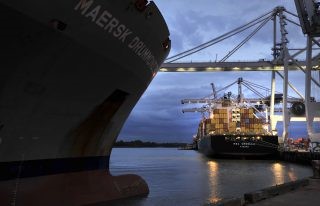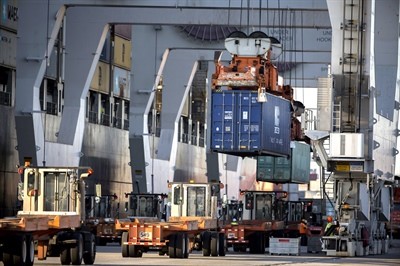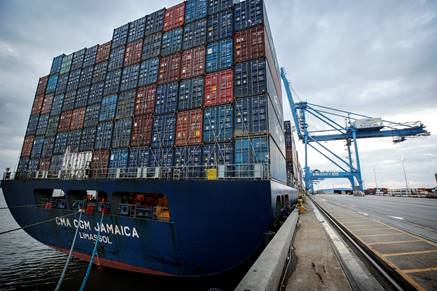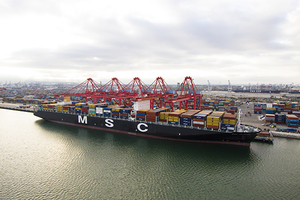
GPA’s Box Volumes up in November

Photo/GPA
Savannah, GA - The Georgia Ports Authority (GPA) reported for the month of November a 6.5 percent increase in total container traffic, which was fueled by a strengthening export market and a busy peak holiday season.
The GPA’s Port of Savannahmoved 167,333 containers, an improvement of 10,210 over November 2015.
For the month, the Port of Savannah handled a record number of loaded container units, amounting to 246,877 TEUs, according to the GPA.
Loaded export TEUs totaled 107,145, an increase of approximately 10 percent, while import loads grew by 12 percent, reaching 139,732 TEUs.
"An increasing demand for America’s exports abroad and strong consumer confidence here at home are helping to boost cargo throughput," Griff Lynch,GPA executive director,said.
Last month, the GPA said that the Port of Savannah achieved its busiest October ever for loaded containers, moving 251,566 TEU container units during the month.
The port handled 8.2 percent of the US containerized cargo volume and 10.3 percent of all US containerized exports in 2015, according to the GPA.
From September through November, the GPA moved nearly 920,000 total TEUs.
Total cargo across all GPA terminals in November reached 2.55 million tons, an increase of 2 percent, or 46,000 tons. Of that figure, container tons totaled 2.25 million tons, with breakbulk at 198,596 tons and bulk cargo totaling 100,802 tons.

Photo/GPA
Enviva Begins Exporting At Port Of Wilmington
Wilmington, NC – The Enviva wood pellet domes at the Port of Wilmington are now operational and the first export shipment to Europe loaded last week. The Enviva terminal, which includes two storage domes that can hold up to 45,000 metric tons of wood pellets each, is estimated to have a total impact on the local economy of more than $16 million per year and ship more than 1 million tons of pellets annually.
"The Port of Wilmington is a key nexus for global commerce and an economic engine for the state of North Carolina," said Enviva CEO John Keppler. "We are excited to be an important part of the port’s ever-increasing volume of trade."
Wood pellets can be delivered to the Port of Wilmington by both truck and rail. The rail link has the capacity to handle approximately 50 percent of the total volume with the remainder of the product arriving by truck.
"The Enviva domes are an important part of our ports modernization plan," said North Carolina Ports Executive Director, Paul J. Cozza. "This project will increase bulk exports, thus expanding the business of our general terminals which is a vital portion of our strategic plan." With facilities that include the terminal at the Port of Wilmington and the Enviva wood pellet production facility in Sampson County, Enviva employs over 100 people in the Cape Fear Region and anticipates an annual economic impact of approximately $160 million. The company has signed a 21-year lease with two five-year renewal options with North Carolina Ports.
"This is about furthering our economic contribution to the City of Wilmington and the State of North Carolina," said North Carolina Ports Chairman Tom Adams. "On top of the 100 jobs Enviva has created, there are nearly 200 additional jobs supported by their shipping, trucking and logging needs and the economic activity those jobs create."
In addition to Enviva, another public-private partnership, the Port of Wilmington Cold Storage Facility (PWCS) recently started its operation at the Port of Wilmington. PWCS is a 101,000-square-foot refrigerated warehouse used to maintain specific temperatures for the storage of perishable goods, such as fruits, vegetables and proteins. The warehouse is located within the gates at the Port of Wilmington and is not only the first on-port cold storage facility in North Carolina, but one of a select few such facilities in the entire nation.
North Carolina’s ports in Wilmington and Morehead City, plus inland terminals in Charlotte and in Greensboro, link the state's consumers, businesses and industry to world markets, and serve as magnets to attract new business and industry to the State of North Carolina. Port activities contribute statewide to 76,000 jobs and $700 million each year in state and local tax revenues.
CMA CGM Announces New Direct Asia Service from Port of New Orleans

New Orleans, LA — Marseilles, France-based CMA CGM on Dec. 22 announced a new direct weekly container service to Asia from the Port of New Orleans Napoleon Avenue Container Terminal. Part of the company’s PEX3 service, the inaugural vessel is scheduled to arrive on January 31, 2017, for service by terminal operator Ports America.
"CMA CGM is proud to be expanding our presence in New Orleans, further showing our commitment to the Gulf region, and Louisiana specifically. We look forward to continued growth in the region, and are pleased to be contributing to the evolution and development of this vital hub. In the U.S., the Group now offers a global coverage with 23 services in and out of North America to over 150 countries around the world," said Marc Bourdon, CMA CGM America LLC President.
The faster transit times provided by the new direct service enhances the Port of New Orleans’ reach for shippers and competitive advantage overall. It also helps both the region and state of Louisiana by serving as a catalyst to attract new business.
"Louisiana is an international gateway for goods bound to and from America’s industrial heartland, and having this new direct service for shippers to vital Asian markets will create greater value for our economy," Louisiana Gov. John Bel Edwards said. "As we see billions of dollars of new industrial investments being made in Louisiana, strategic shipping services by CMA CGM and others will enhance existing import-export operations while making our state even more desirable for foreign direct investment projects."
CMA CGM, the world’s third-largest container carrier, has called at the Port of New Orleans since 2009 and currently operates two weekly services, the Med-Americas Service to the Caribbean and South and Central American ports from New Orleans and the Victory Bridge Service to Northern European ports.
"CMA CGM’s announcement is great news for the Port of New Orleans and Louisiana’s international trade community in that it brings Asia one giant step closer to our doorstep," said Port President and CEO Gary LaGrange. "Our team has worked diligently to attract this service."
Incoming Port President and CEO Brandy Christian said the service will position the Port for future success.
"CMA CGM’s new direct Asia container service will enhance the competitiveness of the Port of New Orleans and Louisiana by providing faster transit times and expanding the port’s reach for shippers," Christian said. "Initiating this service from New Orleans accomplishes a strategic goal for the port and will serve as a catalyst to attract new business to the region. We look forward to working with CMA CGM to ensure the service’s success."
The new service offers a 26-day transit time from Asia to New Orleans, which positions the Port to grow the recently opened Mississippi River Intermodal Terminal’s service to key markets such as Memphis, TN; Chicago, IL; Detroit, MI; Indianapolis, IN and Toronto, which are all serviced daily by CN Railroad. The direct service also adds capacity and reliability for exporters and is strategically timed to serve the surge in resin exports in 2017.
Commission Approves Pact for Port of Long Beach’s Largest Terminal
 Long Beach, CA - New cargo business is coming to the Port of Long Beach’s largest terminal thanks to Harbor Commission approval on Dec. 21 of an agreement replacing a vessel operator that declared bankruptcy.
Long Beach, CA - New cargo business is coming to the Port of Long Beach’s largest terminal thanks to Harbor Commission approval on Dec. 21 of an agreement replacing a vessel operator that declared bankruptcy.